
IoT Data Analytics: Deriving Insights from Connected Devices
Introduction
As an analytics professional in the Internet of Things (IoT) industry, I help organizations make sense of data streaming in from connected devices and sensors. With the exponential growth in IoT adoption, massive volumes of data are being generated from smart homes, wearables, connected cars, industrial machines, and more. My role is to develop analytics solutions that turn this data into valuable, actionable insights.
In this article, I will provide an in-depth look at IoT data analytics – from collecting and storing data to analyzing and deriving insights. I will also cover real-world examples, best practices, challenges, and the future of IoT analytics.
IoT Data Characteristics
Before diving into analytics, it’s important to understand the nature of IoT data:
-
Volume: IoT deployments generate tremendous amounts of data from thousands or millions of sensors and devices. This can be terabytes or petabytes of data per day.
-
Velocity: Data is often streamed in real-time and needs to be analyzed and acted upon quickly. For example, detecting anomalies in industrial equipment.
-
Variety: IoT data comes in many formats from structured logs to unstructured audio, video, and text.
-
Veracity: IoT data can contain noise, errors, and inconsistencies that must be handled.
-
Value: The most important characteristic is generating value from the data through analytics.
These “5 Vs” shape many architectural and analytics decisions as discussed next.
IoT Architecture for Analytics
A typical IoT system for analytics consists of devices/sensors, connectivity, data storage, and analytics:
Devices and Sensors: These collect and transmit data such as temperature, pressure, location, speed, images, etc. Protocols like MQTT and ZigBee enable device communication.
Connectivity: This allows data transmission from devices to other parts of the system. Networks like 2G/3G, WiFi, Bluetooth, LPWAN are common.
Data Storage: Stores the high-velocity data streams for later retrieval and analysis. This includes cloud storage like AWS S3, and databases like Cassandra.
Analytics: This is the brain that analyzes the stored data and extracts value from it. From SQL queries to machine learning, many analytics techniques can be applied. Dashboards and apps deliver insights to users.
Now let’s look at analytics techniques for IoT data.
Analytics Techniques for IoT Data
IoT analytics employs traditional and advanced techniques tailored to the data characteristics:
Data Exploration
-
Descriptive statistics like averages, counts, min/max help better understand data.
-
Data visualization like histograms, scatter plots surface patterns.
-
Geo-visualization maps geospatial data from sensors.
Descriptive Analytics
-
Aggregations like sums, counts are used for reporting.
-
Business Intelligence tools produce IoT reports and dashboards.
Diagnostic Analytics
-
Funnel analysis of manufacturing process data identifies bottlenecks.
-
Root cause analysis pinpoints faults leading to failures.
-
Drill-down analysis dives into details from high-level aggregates.
Predictive Analytics
-
Regression algorithms model electricity consumption based on IoT sensor data.
-
Machine learning techniques like random forests predict future events.
-
Time-series analysis is used for forecasting using temporal IoT data.
Prescriptive Analytics
-
Optimization algorithms prescribe optimal actions like minimizing energy usage.
-
Decision models suggest best strategies from various choices.
-
Simulation modeling evaluates hypothetical scenarios with IoT data.
IoT Analytics in Action
Now I will highlight real-world examples of deriving value from IoT data across industries:
Smart Homes
-
Smart thermostats optimize HVAC usage by learning from occupancy patterns. This cuts energy bills.
-
Smart lighting systems adjust lights based on time of day and home occupancy.
-
Water leak detectors alert homeowners of leaks before major damage occurs. Plumbers can be proactively dispatched.
Smart Cities
-
Analyzing real-time traffic data from cameras and sensors to optimize signal timings and reduce congestion.
-
Sensors monitoring air quality guide policies for reducing pollution.
-
Smart meters and analytics pinpoint water pipe leaks for preventive maintenance.
Industrial IoT
-
Predictive maintenance algorithms utilize machine sensor data to detect issues and prevent downtime.
-
Tracking asset locations with RFID tags optimizes logistics in warehouses.
-
Monitoring product metrics at each manufacturing stage improves quality control.
Connected Health
-
Wearables like smart watches track vital signs to detect medical conditions early.
-
Aggregate fitness tracker data aids population health research studies.
-
Remote patient monitoring systems alert doctors of problems between visits.
Challenges with IoT Analytics
While IoT analytics unlocks many opportunities, I also face challenges on the job:
-
Data quality issues like missing values, noise, and errors make analysis difficult. Proper data cleansing is essential.
-
Data integration across different devices, formats, and protocols is complex and time-consuming.
-
Data security and privacy concerns arise with personal data like location and biometrics. Encryption and anonymity is needed.
-
Scalability of analytics has to match IoT systems scaling to millions of events and terabytes of data.
-
Real-time analytics with millisecond response times is challenging with streaming data. Special frameworks help.
-
Talent shortage of analytics professionals skilled at IoT data techniques persists in the industry.
The Future of IoT Analytics
Looking ahead, I see several promising areas for IoT analytics:
-
Edge analytics: Processing and analyzing data on local devices reduces costs and latency.
-
Contextual analytics: Analyzing contextual data like video and sound from IoT improves insights.
-
Blockchain: Shared tamper-proof ledgers build trust in data exchange between IoT systems.
-
5G networks: Faster 5G enables new bandwidth-intensive IoT applications.
-
AI and machine learning: Sophisticated models uncover hidden patterns and improve automated decision making.
-
Digital twins: Pairing physical assets with digital models aids simulation and what-if analysis.
Conclusion
In closing, deriving value from massive volumes of IoT data is crucial and analytics makes it possible. With the right architecture, techniques, and skillset, organizations can optimize operations, uncover insights, and improve services using data from connected devices and sensors. However, challenges around data, scalability, real-time processing, and talent shortage must also be addressed. As IoT expands, analytics will become pivotal to harnessing its full potential.












